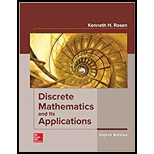
Concept explainers
Use a table to express the values of each of these Boolean functions.
a)
b)
c)
d)
Want to see the full answer?
Check out a sample textbook solution
Chapter 12 Solutions
DISCRETE MATHEMATICS+ITS APPL. (LL)-W/A
Additional Math Textbook Solutions
Precalculus: A Unit Circle Approach (3rd Edition)
Pathways To Math Literacy (looseleaf)
Elementary Statistics
Elementary and Intermediate Algebra: Concepts and Applications (7th Edition)
Finite Mathematics for Business, Economics, Life Sciences and Social Sciences
Intro Stats, Books a la Carte Edition (5th Edition)
- Find all values of x for the given function where the tangent line is horizontal. 3 =√x³-12x² + 45x+5arrow_forwardFind the equation of the tangent line to the graph of the given function at the given value of x. 6 f(x) = x(x² - 4x+5)*; x=2arrow_forward7. Suppose that X is a set, that I is a nonempty set, and that for each i Є I that Yi is a set. Suppose that I is a nonempty set. Prove the following:2 (a) If Y; CX for all i EI, then Uiel Yi C X. ¹See Table 4.8.1 in zyBooks. Recall: Nie X₁ = Vi Є I (x = X₁) and x = Uier X₁ = i Є I (x Є Xi). (b) If XCY; for all i Є I, then X Ciel Yi. (c) U(x)=xnUY. iЄI ΕΙarrow_forward
- 8. For each of the following functions, determine whether or not it is (i) injective and/or (ii) surjective. Justify why or why not. (a) fiZZ defined by fi(n) = 2n. (b) f2 RR defined by f2(x) = x² − 4x+7. : (c) f3 Z {0, 1} defined by f3(n) = 0 if n is even and f3(n) = 1 if n is odd. (d) f4 Z N defined by f4(n) = 2n if n > 0 and f4(n) = -2n-1 if n < 0.arrow_forward2. Disprove the following by finding counterexamples: 3. (a) For all sets A and B, AU (BNA) = B. (b) For all sets A, B, and C, ANBCC if and only if ACC and B C C. Suppose A and B are subsets of a universal set U. Using the set identities¹ prove the following: (a) (ANB) U(ANB) = B (b) A (BA) = Aarrow_forwardNo chatgpt pls will upvotearrow_forward
- Algebra & Trigonometry with Analytic GeometryAlgebraISBN:9781133382119Author:SwokowskiPublisher:Cengage
 Algebra: Structure And Method, Book 1AlgebraISBN:9780395977224Author:Richard G. Brown, Mary P. Dolciani, Robert H. Sorgenfrey, William L. ColePublisher:McDougal Littell
Algebra: Structure And Method, Book 1AlgebraISBN:9780395977224Author:Richard G. Brown, Mary P. Dolciani, Robert H. Sorgenfrey, William L. ColePublisher:McDougal Littell Elements Of Modern AlgebraAlgebraISBN:9781285463230Author:Gilbert, Linda, JimmiePublisher:Cengage Learning,
Elements Of Modern AlgebraAlgebraISBN:9781285463230Author:Gilbert, Linda, JimmiePublisher:Cengage Learning,  Linear Algebra: A Modern IntroductionAlgebraISBN:9781285463247Author:David PoolePublisher:Cengage Learning
Linear Algebra: A Modern IntroductionAlgebraISBN:9781285463247Author:David PoolePublisher:Cengage Learning Elementary Linear Algebra (MindTap Course List)AlgebraISBN:9781305658004Author:Ron LarsonPublisher:Cengage Learning
Elementary Linear Algebra (MindTap Course List)AlgebraISBN:9781305658004Author:Ron LarsonPublisher:Cengage Learning




